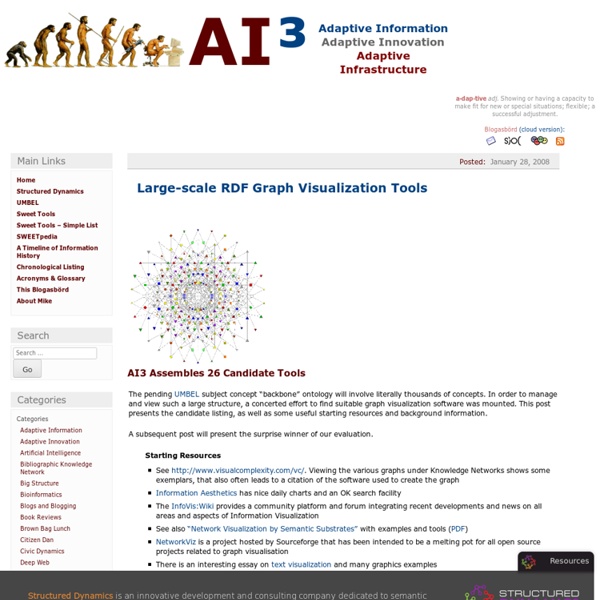hands system
I still never cease to be amazed at how wonderful and powerful tools are so often and easily overlooked. The most recent example is Cytoscape, a winner in our recent review of more than 25 tools for large-scale RDF graph visualization. We began this review because the UMBEL subject concept “backbone” ontology will involve literally thousands of concepts. Graph visualization software suitable to very large graphs would aid UMBEL’s construction and refinement. Cytoscape describes itself as a bioinformatics software platform for visualizing molecular interaction networks and integrating these interactions with gene expression profiles and other state data.
Connections in Time
Some relationships change over time. Think about your friends from high school, college, work, the city you used to live in, the ones that liked you ex- better, etc. When exploring a social network it is important that we understand not only the strength of the relationship now, but over time. We can use communication between people as a measure. I ran into a visualization that explored how multiple parties where connected by communications in multiple projects.
Mapping Social Networks
The growth of social networks such as Facebook and MySpace has introduced the idea of the 'social graph' into common parlance. the social graph is Watch this short video describing the proof of concept Vizter social network browser visualisation: Vizter explanatory video. How does vizter allow you to identify friends you have in common with other people? How does vizter help the user identify possible communities in the social graph?
eVa in 3-color
For a whole number of reasons, I am currently looking into the visualisation of large-scale graphs and ontologies and to that end, I have made some notes concerning tools and concepts which might be useful for others. Here they are: Visualisation by Node-Link and Tree
HyperGraphDB - A Graph Database
HyperGraphDB is a general purpose, extensible, portable, distributed, embeddable, open-source data storage mechanism. It is a graph database designed specifically for artificial intelligence and semantic web projects, it can also be used as an embedded object-oriented database for projects of all sizes. The system is reliable and in production use is several projects, including a search engine and our own Seco scripting IDE where most of the runtime environment is automatically saved as a hypergraph. HyperGraphDB is primarily what its carefully chosen name implies: a database for storing hypergraphs. While it falls into the general family of graph databases, it is hard to categorize HyperGraphDB as yet another database because much of its design evolves around providing the means to manage structure-rich information with arbitrary layers of complexity.
Vizster: Visualizing Online Social Networks
VizsterVisualizing Online Social Networks Jeffrey Heer – jheer@cs.berkeley.edu Professor Marti Hearst InfoSys 247 – Information Visualization University of California, Berkeley Spring Semester, 2004
Graph database
Graph databases are part of the NoSQL databases created to address the limitations of the existing relational databases. While the graph model explicitly lays out the dependencies between nodes of data, the relational model and other NoSQL database models link the data by implicit connections. Graph databases, by design, allow simple and fast retrieval[citation needed] of complex hierarchical structures that are difficult to model[according to whom?] in relational systems.
Interactive Infographic with SVG and CSS Animations
Learn how to build an interactive animated infographic using SVG, CSS and JavaScript. View demo Download source One of the less talked about features of newer browsers is increasing support for the SVG file format. If you are unfamiliar with SVG, it stands for Scalable Vector Graphics. Unlike raster image formats like PNG, JPG or GIF, the vector graphics contained within SVG files are completely scalable to any size and will display at any resolution or screen density without quality loss. In many cases, SVG files will also be much smaller in filesize and download quicker.
eumedis approach
Supports the development of information society in the Mediterranean Partner Countries, through promoting information and communication technologies Algeria, Egypt, Israel, Jordan, Lebanon, Morocco, Occupied Palestinian Territory, Syria, Tunisia, Turkey Timeframe: 1999-2007 Budget: €65 million (MEDA) Objectives It aims at contributing towards the development and modernisation of the Euro-Mediterranean Information Society, and thus bring about economic development, improve quality of life and promote understanding.
The 15 best tools for data visualisation
It's often said that data is the new world currency, and the web is the exchange bureau through which it's traded. As consumers, we're positively swimming in data; it's everywhere from labels on food packaging design to World Health Organisation reports. As a result, for the designer it's becoming increasingly difficult to present data in a way that stands out from the mass of competing data streams.
15 Effective Tools for Visual Knowledge Management
Since I started my quest a few years ago searching for the ultimate knowledge management tool, I’ve discovered a number of interesting applications that help people efficiently organize information. There certainly is no shortage of solutions for this problem domain. Many tools exist that offer the ability to discover, save, organize, search, and retrieve information.



